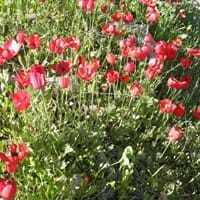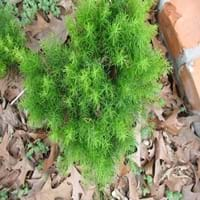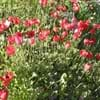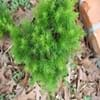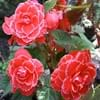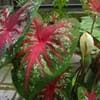Life Span
Perennial
Perennial
Type
Bulb or Corm or Tuber
Bulb or Corm or Tuber
Origin
Southern Europe, Mediterranean
South Africa
Types
Not Available
Asparagus setaceus, Asparagus 'Sprengeri', Asparagus meyeri
Habitat
damp meadows, Dry areas, Woodland edges
Moist Soils
USDA Hardiness Zone
8-12
9-15
AHS Heat Zone
12-3
Not Available
Habit
Upright/Erect
Arching/Fountain-shaped
Flower Color
White, Red, Blue, Pink
White
Flower Color Modifier
Bicolor
Bicolor
Fruit Color
Not Available
Red, Orange Red
Leaf Color in Spring
Green
Green, Lime Green
Leaf Color in Summer
Light Green
Light Green
Leaf Color in Fall
Several shades of Green
Several shades of Green
Leaf Color in Winter
Light Green
Light Green
Leaf Shape
Lobed
Needle like
Plant Season
Spring, Winter
Spring, Summer, Fall, Winter
Sunlight
Full Sun, Partial Sun, Partial shade
Partial Sun, Partial shade
Type of Soil
Loam, Sand
Loam, Sand
The pH of Soil
Acidic, Neutral, Alkaline
Acidic, Neutral, Alkaline
Soil Drainage
Well drained
Well drained
Bloom Time
Early Spring, Spring, Late Winter, Indeterminate
Summer
Tolerances
Drought
Drought
Where to Plant?
Ground, Pot
Container, Ground, Pot
How to Plant?
Seedlings, Tuber propagation
Divison, Seedlings
Plant Maintenance
Medium
Medium
Watering Requirements
Medium
Average Water Needs, Medium
In Summer
Lots of watering
Lots of watering
In Spring
Moderate
Moderate
In Winter
Average Water
Average Water
Soil pH
Acidic, Neutral, Alkaline
Acidic, Neutral, Alkaline
Soil Type
Loam, Sand
Loam, Sand
Soil Drainage Capacity
Well drained
Well drained
Sun Exposure
Full Sun, Partial Sun, Partial shade
Partial Sun, Partial shade
Pruning
Remove damaged leaves, Remove dead branches, Remove dead leaves
Cut back old stems to the ground, Pinching, Remove damaged leaves, Remove dead branches, Remove dead leaves, Remove dead or diseased plant parts, Remove deadheads
Fertilizers
All-Purpose Liquid Fertilizer
All-Purpose Liquid Fertilizer, Balanced garden plant fertilizer, fertilize in fall, fertilize in spring
Pests and Diseases
Cutworms
Red blotch
Plant Tolerance
Drought
Drought
Flower Petal Number
Single, Double, Semi-Double
Single
Edible Fruit
No
Not Available
Fragrant Flower
No
Not Available
Fragrant Fruit
No
Not Available
Fragrant Leaf
No
Not Available
Fragrant Bark/Stem
No
Not Available
Foliage Texture
Fine
Fine
Foliage Sheen
Matte
Glossy
Attracts
Butterflies, Hummingbirds, pollinators
Bees, Birds, Butterflies, Hummingbirds
Allergy
Not Available
Abdominal pain, Dermatitis, Diarrhea, Skin irritation, Skin rash, Toxic, Vomiting
Aesthetic Uses
Borders, Cottage Garden
Hanging Basket, Landscape Designing, Showy Purposes
Beauty Benefits
Not Available
Not Available
Edible Uses
No
Insignificant
Environmental Uses
Air purification
Air purification, Provides ground cover
Medicinal Uses
Antitumor, Cramps
Not Available
Part of Plant Used
Flowers, Leaves
Stem
Other Uses
Unknown
Container, useful as a ground cover
Used As Indoor Plant
No
Yes
Used As Outdoor Plant
Yes
Yes
Garden Design
Bedding Plant, Container, Cutflower, Mixed Border, Rock Garden / Wall
Container, Groundcover, Hanging Basket, Houseplant, Tropical
Botanical Name
ANEMONE coronaria
ASPARAGUS densiflorus 'Sprengeri Compacta'
Common Name
Crown Windflower, Lilies-of-the-Field, Poppy-flowered Anemone, wind flower
Asparagus Fern, Compact Asparagus Fern, Sprenger's Asparagus Fern
In Hindi
Poppy Flowered Anemone
Asparagus Fern Plant
In German
Kronen-Anemone
Spargel Farnanlage
In French
Anémone couronnée
Asperges Fern Plante
In Spanish
Poppy flowered Anemone
Planta del helecho de espárragos
In Greek
Poppy Flowered Anemone
Σπαράγγια Fern Plant
In Portuguese
Poppy Flowered Anemone
Espargos Planta Fern
In Polish
Zawilec wieńcowy
Szparagi Fern roślin
In Latin
Poppy Flowered Anemone
Asparagus Fern Plant Families
Phylum
Anthophyta
Vascular plant
Class
Equisetopsida
Liliopsida
Order
Ranunculales
Asparagales
Family
Ranunculaceae
Liliaceae
Clade
Angiosperms, Eudicots
Angiosperms, Monocots
Tribe
Not Available
Not Available
Subfamily
Not Available
Asparagoideae
Number of Species
Not Available
Season and Care of Poppy Flowered Anemone and Asparagus Fern
Season and care of Poppy Flowered Anemone and Asparagus Fern is important to know. While considering everything about Poppy Flowered Anemone and Asparagus Fern Care, growing season is an essential factor. Poppy Flowered Anemone season is Spring and Winter and Asparagus Fern season is Spring and Winter. The type of soil for Poppy Flowered Anemone is Loam, Sand and for Asparagus Fern is Loam, Sand while the PH of soil for Poppy Flowered Anemone is Acidic, Neutral, Alkaline and for Asparagus Fern is Acidic, Neutral, Alkaline.
Poppy Flowered Anemone and Asparagus Fern Physical Information
Poppy Flowered Anemone and Asparagus Fern physical information is very important for comparison. Poppy Flowered Anemone height is 30.50 cm and width 10.20 cm whereas Asparagus Fern height is 60.96 cm and width 121.92 cm. The color specification of Poppy Flowered Anemone and Asparagus Fern are as follows:
Poppy Flowered Anemone flower color: White, Red, Blue and Pink
Poppy Flowered Anemone leaf color: Green
Asparagus Fern flower color: White
- Asparagus Fern leaf color: Green and Lime Green
Care of Poppy Flowered Anemone and Asparagus Fern
Care of Poppy Flowered Anemone and Asparagus Fern include pruning, fertilizers, watering etc. Poppy Flowered Anemone pruning is done Remove damaged leaves, Remove dead branches and Remove dead leaves and Asparagus Fern pruning is done Cut back old stems to the ground, Pinching, Remove damaged leaves, Remove dead branches, Remove dead leaves, Remove dead or diseased plant parts and Remove deadheads. In summer Poppy Flowered Anemone needs Lots of watering and in winter, it needs Average Water. Whereas, in summer Asparagus Fern needs Lots of watering and in winter, it needs Average Water.
